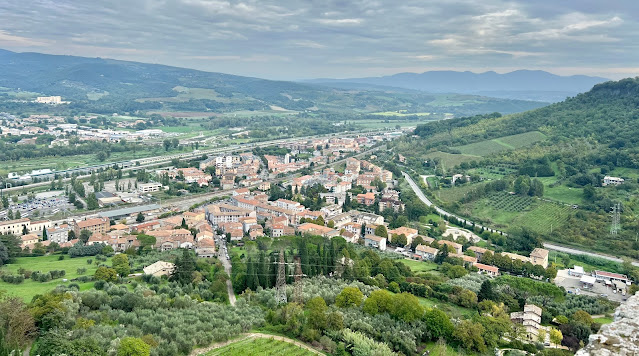Orvieto, the Umbrian city from which the surrounding wine region takes its name, is perched atop an outcrop of volcanic rock. Our Orvieto wine country explorations took us through hilly landscapes, passing endless vineyards along the way. This post highlights our visit to this historic city, which dates back to the Etruscan era, long before it became a stronghold of the Roman Empire. Underneath Orvieto's cobbled alleyways and medieval piazzas, there is a network of underground caves dating back to the city’s ancient origins. It was in these underground cellars that the Etruscans produced the first wines for Orvieto clergy. The city is surrounded by sweeping hills and fields of vineyards as far as the eye can see. During our visit to Orvieto we explored its historic center, and took in panoramic views of the surrounding countryside.
Getting to Know Orvieto
A stop at Giardini Comunali di Orvieto before entering the city center is a good idea however, we did it at the end. Either way it is a must visit to take in the views. A large tuff stone arch is at the main entrance. From this site you get incredible views overlooking the Paglia river and the surrounding Umbrian countryside. Umbria is defined by hills, mountains, valleys and historical towns such Orvieto, Todi, and other small cities/villages. It is often referred to as the green heart of Italy where travelers delight in exploring its medieval hilltop towns, dense forests, and local cuisine (especially truffles and wines). When we visited Decugnano Dei Barbi in Orvieto wine country, from there we saw this historic city in the distance. Once you see the city of Orvieto in the distance you are compelled to visit, and we did.
Orvieto in the Distance © Spaswinefood
Orvieto, the city from which the wine region takes its name, is perched atop an outcrop of volcanic rock. The Orvieto Citadel can be seen for many miles around. Winemaking began here during the Etruscan era when a network of underground caves was established. Today, winemaking is a cornerstone of Orvieto’s economy, and the city is surrounded by sweeping hills and fields of vineyards as far as the eye can see. Orvieto is Umbria’s most productive wine area, accounting for around 80% of Umbria’s total vineyard area.
After we arrived in the parking lot at the outskirts of historic center we head towards the historic center, which is pedestrian friendly.
Off we went to the historic town center.
Soon we are heading down even narrower streets.
Every time we dined out in Umbria we made an effort to try the local wines. Orvieto’s most famous wines are whites, made from blends of Grechetto and Trebbiano grapes. For a wine to be certified Orvieto DOC, it must consist of at least 60% of this blend.
Now here are the pastas we had.
I am sure we shared a dessert. We were quite please with our lunch option. Obviously, we need more time to explore both cuisine and the city. I suppose, that would a good reason to return in the future.
After lunch we headed back to the parking lot, enjoying historic Orvieto along the way. Along the way we spotted historical buildings, language schools and more.
We dropped by Giardini Comunali di Orvieto to take in the panoramic views before driving back to our accommodations in Izzalini. Our week in Umbria passed far too quickly, as we visited its historic towns and explored wine country. Umbria is a region with a proud history and age-old tradition for winemaking. Moreover, the area can rival anywhere in the country for its natural beauty. Other than Orvieto wine country Umbria’s best known wine sub-regions also include Assisi, and Montefalco. My earlier articles focused on winery visits in Orvieto wine country and Montefalco. I invite you to join me in our wine travels in Italy and elsewhere at Wine Travels with Dr. Sharon, and at Spaswinefood on Twitter and Facebook. I am so looking forward to sharing our vine-filled explorations in Italy.
























No comments:
Post a Comment